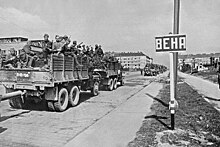9th Guards Army
| 9th Guards Army | |
|---|---|
| Active | 1945–1946 |
| Country | |
| Branch | Red Army |
| Type | Combined arms |
| Size | 3 rifle corps |
| Part of | 2nd Ukrainian Front 3rd Ukrainian Front |
| Engagements | World War II |
| Commanders | |
| Notable commanders | Vasily Glagolev |
The9th Guards Armywas afield armyof theRed ArmyduringWorld War II,which fought in theVienna Offensiveand thePrague Offensiveat the end of the war. The army was formed in January 1945 and included airborne divisions converted into infantry. Postwar, the army headquarters becameSoviet airborneheadquarters.
History
[edit]Formation
[edit]The 9th Guards Army was formed on 5 January 1945 under the command ofVasily Glagolevas directed by theStavkadirective of 18 December 1944.[1]It was formed from the headquarters of the7th Armyand theSeparate Airborne Army.[2]It was composed of the37th,38thand39th Guards Rifle Corps.In February, the army was transferred to southeasternHungary,nearBudapest.It became part of the2nd Ukrainian Fronton 27 February to participate in the Vienna Offensive.[1][3]
Vienna and Prague Offensives
[edit]
It was transferred to the3rd Ukrainian Fronton 9 March. Between 8 and 14 March the army was moved from theKecslemetarea across theDanubeinto theZámolysector, replacing the4th Guards Army.[4]Between 16 March and 15 April, the army fought in the Vienna Offensive. Units of the army broke through German defences north ofSzékesfehérvárin conjunction with the4th Guards Army.Advancing in the left flank and rear of the6th Panzer Army,the 9th Guards Army broke through other German units betweenLake BalatonandVelence.For the assault on Vienna, the army's 39th Guards Rifle Corps would follow the attack of the6th Guards Tank Armyin the southwestern sector. The 38th Guards Rifle Corps was to cut the Vienna-Linz road and use two divisions to protect the attack from the west. The 37th Guards Rifle Corps protected the assault force's left flank. The 9th Guards Army attacked the northwestern road out ofViennain conjunction with the6th Guards Tank Armyand broke German resistance in early April. On 13 April, the army helped capture Vienna.[5]The army then fought in thePrague Offensive,where it capturedZnojmoon 8 May in conjunction with the7th Guards Army.It also capturedRetzandPísek,ending the war on theElbe.[1][6]
Postwar
[edit]The army had its headquarters inSzolnokfrom July 1945 to June 1946 and was part of theCentral Group of Forces.[7]In 1946, its headquarters became theSoviet airborneheadquarters and its corps were converted into airborne corps, while rifle divisions became airborne divisions.[8]
Composition
[edit]The army was composed of the following units in February 1945.[9]
- 37th Guards Rifle Corps
- 38th Guards Rifle Corps
- 39th Guards Rifle Corps
- 35th Guards Gun Artillery Brigade
- 36th Anti-Tank Artillery Brigade
- 319th Guards Mortar Regiment
- 321st Guards Mortar Regiment
- 322nd Guards Mortar Regiment
- 1513th Self-Propelled Artillery Regiment
- 1523rd Self-Propelled Artillery Regiment
- 1524th Self-Propelled Artillery Regiment
- 15th Engineer-Sapper Brigade
- 7th Separate Flamethrower Battalion
References
[edit]- ^abc"9-я ГВАРДЕЙСКАЯ АРМИЯ"[9th Guards Army].bdsa.ru(in Russian). Archived fromthe originalon 20 April 2019.Retrieved25 November2015.
- ^Feskov et al 2003,p. 21.
- ^Erickson 1999,p. 510.
- ^Glantz 2012,pp. 517–520.
- ^Erickson 1999,p. 549.
- ^"9-я гвардейская армия"[9th Guards Army].samsv.narod.ru(in Russian).Retrieved25 November2015.
- ^Holm, Michael."9th Guards Combined Arms Army".ww2.dk.Retrieved25 November2015.
- ^Feskov et al 2013,p. 234.
- ^Combat composition of the Soviet Army,1 February 1945
- Erickson, John (1999) [1983].Stalin's War with Germany: The road to Berlin.New Haven: Yale University Press.ISBN9780300078138.
- Feskov, V.I.; Kalashnikov, K.A.; Golikov, V.I. (2003).Красная Армия в победах и поражениях 1941–1945 гг[The Red Army in the victories and defeats 1941–1945](PDF)(in Russian). Tomsk: Tomsk University Press.ISBN5751116240.
- Feskov, V.I.; Golikov, V.I.; Kalashnikov, K.A.; Slugin, S.A. (2013).Вооруженные силы СССР после Второй Мировой войны: от Красной Армии к Советской[The Armed Forces of the USSR after World War II: From the Red Army to the Soviet: Part 1 Land Forces] (in Russian). Tomsk: Scientific and Technical Literature Publishing.ISBN9785895035306.
- Glantz, David M. (2012) [1989].Soviet Military Deception in the Second World War.Abingdon-on-Thames: Routledge.ISBN9781136287657.
